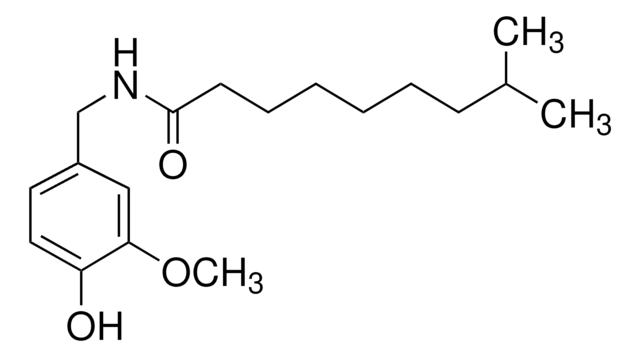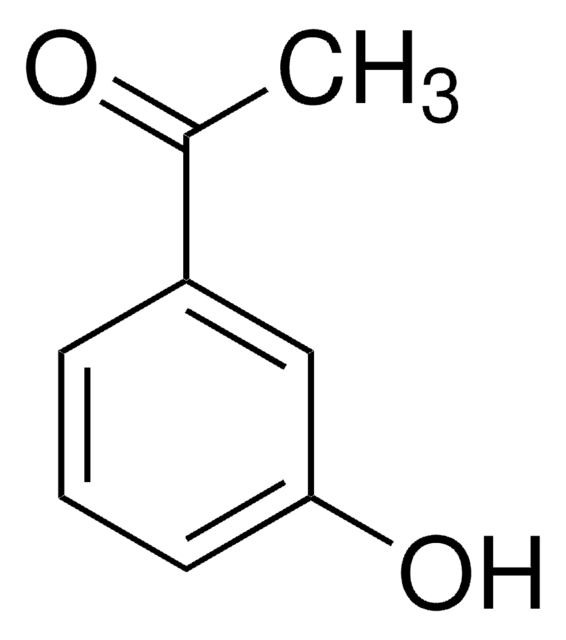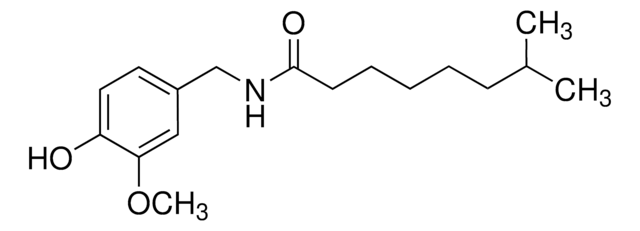360376
Capsaicin
63.7% (HPLC), powder, TRPV1 agonist
Sinonimo/i:
8-Methyl-N-vanillyl-trans-6-nonenamide
About This Item
Prodotti consigliati
Nome del prodotto
Capsaicin, natural
Grado
natural
Livello qualitativo
Saggio
63.7% (HPLC)
Stato
powder
Composizione
capsaicin, 65%
dihydrocapsaicin, 35%
Punto di fusione
62-65 °C (lit.)
Solubilità
chloroform: 5%
Temperatura di conservazione
2-8°C
Stringa SMILE
COc1cc(CNC(=O)CCCC\C=C\C(C)C)ccc1O
InChI
1S/C18H27NO3/c1-14(2)8-6-4-5-7-9-18(21)19-13-15-10-11-16(20)17(12-15)22-3/h6,8,10-12,14,20H,4-5,7,9,13H2,1-3H3,(H,19,21)/b8-6+
YKPUWZUDDOIDPM-SOFGYWHQSA-N
Informazioni sul gene
human ... CYP1A2(1544) , TRPV1(7442)
rat ... Trpv1(83810) , Trpv4(66026)
Cerchi prodotti simili? Visita Guida al confronto tra prodotti
Descrizione generale
Applicazioni
Azioni biochim/fisiol
Avvertenze
Danger
Indicazioni di pericolo
Consigli di prudenza
Classi di pericolo
Acute Tox. 2 Oral - Eye Dam. 1 - Resp. Sens. 1 - Skin Irrit. 2 - Skin Sens. 1 - STOT SE 3
Organi bersaglio
Respiratory system
Codice della classe di stoccaggio
6.1A - Combustible acute toxic Cat. 1 and 2 / very toxic hazardous materials
Classe di pericolosità dell'acqua (WGK)
WGK 3
Punto d’infiammabilità (°F)
235.4 °F - closed cup
Punto d’infiammabilità (°C)
113 °C - closed cup
Dispositivi di protezione individuale
Eyeshields, Faceshields, Gloves, type P2 (EN 143) respirator cartridges
Scegli una delle versioni più recenti:
Possiedi già questo prodotto?
I documenti relativi ai prodotti acquistati recentemente sono disponibili nell’Archivio dei documenti.
I clienti hanno visto anche
Articoli
Palladacyclic catalysts developed by Bedford’s group are examples of a select group of catalysts capable of affecting a variety of coupling reactions using difficult to activate aryl chlorides at very low catalyst loadings.
Il team dei nostri ricercatori vanta grande esperienza in tutte le aree della ricerca quali Life Science, scienza dei materiali, sintesi chimica, cromatografia, discipline analitiche, ecc..
Contatta l'Assistenza Tecnica.








